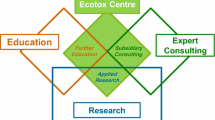Abstract
Background
Modern societies depend on environmental sustainability and on new generations of individuals well-trained by environmental research and teaching institutions. In the past, significant contributions to the identification, assessment, and management of chemical stressors with legal consequences have been made.
Main Features
Within this article, we intend to elucidate the merits and the emerging challenges of chemicals-related environmental sciences. The manuscript is supported by more than 70 professors and university academics of leading institutions in Germany, Switzerland, Austria, and other countries in Europe, but addresses topics of global concern.
Results and Discussion
Many environmental problems of pollutants remain to be addresses, since new chemical compounds or classes of new compounds are continuously developed and brought to the market and sooner or later “emerge” in the environment. Further issues are the inclusion of transformation products and chemical mixtures in environmental risk assessment, the long-term presence of xenobiotics bound to soils and sediments, as well as an understanding of the ecological relevance of ecotoxicological end points.
Conclusion and Perspectives
We point out the need for a strong academic research and education system in chemicals-related environmental sciences to ministries, politicians, and research funding institutions and we propose to create specific units in the national funding bodies that address basic and interdisciplinary research in this field.

Similar content being viewed by others
References
Ahlers J, Stock F, Werschkun B (2008) Integrated testing and intelligent assessment—new challenges under REACH. Environ Sci Pollut Res Int 15:565–572
Albin M (2006) Göteborgs Posten. Available at http://gp.se/gp/jsp/Crosslink.jsp?d=114&a=309738
Backhaus T, Faust M, Scholze M, Gramatica P, Vighi M, Grimme LH (2004) Joint algal toxicity of phenylurea herbicides is equally predictable by concentration addition and independent action. Environ Toxicol Chem 23:258–264
Daughton CG, Ternes TA (1999) Pharmaceuticals and personal care products in the environment: agents of subtle change? Environ Health Perspect 107(Suppl 6):907–938
Ehrlich PR, Wilson EO (1991) Biodiversity studies—science and policy. Science 253:758–762
EPA (2001) European Environment Agency, environmental issue report no. 22 P. Harremoës et al. (eds) Copenhagen, 209 pp
Filser J (2008) Ecotoxicology and ecosystems: relevance, restrictions, research needs. Basic Appl Ecol 9:333–336
Fischer HC, Chan WC (2007) Nanotoxicity: the growing need for in vivo study. Curr Opin Biotechnol 18:565–571
Gianfreda L, Rao MA (2008) Interactions between xenobiotics and microbial and enzymatic soil activity. Crit Rev Environ Sci Technol 38:269–310
Jablonowski ND, Modler J, Schaeffer A, Burauel P (2008) Bioaccessibility of environmentally aged 14C-atrazine residues in an agriculturally used soil and its particle-size aggregates. Environ Sci Technol 42:5904–5910
Kaiser J (2007) Ecotoxicology. Canadian study reveals new class of potential POPs. Science 317:182–183
Kates RW et al (2001) Environment and development—sustainability science. Science 292:641–642
Kaykhaii M, Mirbaloochzahi MR (2008) Direct screening of ground water samples for fuel oxygenates by headspace liquid phase microextraction–gas chromatography. Environ Monit Assess 147:211–222
Kelly BC, Ikonomou MG, Blair JD, Morin AE, Gobas FA (2007) Food web-specific biomagnification of persistent organic pollutants. Science 317:236–239
Marvier M, McCreedy C, Regetz J, Kareiva P (2007) A meta-analysis of effects of Bt cotton and maize on nontarget invertebrates. Science 316:1475–1477
Nel A, Xia T, Madler L, Li N (2006) Toxic potential of materials at the nanolevel. Science 311:622–627
Olsman H, Engwall M, Kammann U, Klempt M, Otte J, Bavel B, Hollert H (2007) Relative differences in aryl hydrocarbon receptor-mediated response for 18 polybrominated and mixed halogenated dibenzo-p-dioxins and -furans in cell lines from four different species. Environ Toxicol Chem 26:2448–2454
Rowe D (2007) Sustainability—education for a sustainable future. Science 317:323–324
Schaffer A, van den Brink P, Heimbach F, Hoy S, de Jong F, Rombke J, Sousa JP, Ross-Nickoll M (2008) Semi-field methods are a useful tool for the environmental risk assessment of pesticides in soil. Environ Sci Pollut Res Int 15:176–177
Scheringer M (2008) Nanoecotoxicology: environmental risks of nanomaterials. Nat Nanotechnol 3:322–323
Schulz R, Stehle S, Elsaesser D, Matezki S, Ller A, Neumann M, Ohliger R, Wogram J, Zenker K (2009) Geodata-based probabilistic risk assessment and management of pesticides in Germany: a conceptual framework. Integrated Environ Assess Manag 5:69–79
Schwarzenbach RP, Escher BI, Fenner K, Hofstetter TB, Johnson CA, von Gunten U, Wehrli B (2006) The challenge of micropollutants in aquatic systems. Science 313:1072–1077
Skutlarek D, Exner M, Farber H (2006) Perfluorinated surfactants in surface and drinking waters. Environ Sci Pollut Res Int 13:299–307
Theodorakis CW (1999) Integration of genotoxic and population genetic endpoints in biomonitoring and risk assessment. Proceedings of the 20th Annual Meeting of the Society-of-Environmental-Toxicology-and-Chemistry, Philadelphia, Pennsylvania, pp 245–256
UN (2005) Available at http://portal.unesco.org/education/en/ev.php-URL_ID=27552&URL_DO=DO_TOPIC&URL_SECTION=201.html
Van den Brink PJ (2008) Ecological risk assessment: from book-keeping to chemical stress ecology. Environ Sci Technol 42:8999–9004
van Straalen NM, Timmermans M (2002) Genetic variation in toxicant-stressed populations: an evaluation of the “genetic erosion” hypothesis. Hum Ecol Risk Assess 8:983–1002
Weber R et al (2008a) Dioxin- and POP-contaminated sites—contemporary and future relevance and challenges: overview on background, aims and scope of the series. Environ Sci Pollut Res Int 15:363–393
Weber R, Tysklind M, Gaus C (2008b) Dioxin—contemporary and future challenges of historical legacies. Dedicated to Prof. Dr. Otto Hutzinger, the founder of the DIOXIN Conference Series. Environ Sci Pollut Res Int 15:96–100
Wiesner MR, Lowry GV, Alvarez P, Dionysiou D, Biswas P (2006) Assessing the risks of manufactured nanomaterials. Environ Sci Technol 40:4336–4345
Yeston J, Coontz R, Smith J, Ash C (2006) A thirsty world—introduction. Science 313:1067–1067
Author information
Authors and Affiliations
Corresponding author
Electronic supplementary material
ESM 1
(DOC 29 kb)
Rights and permissions
About this article
Cite this article
Schaeffer, A., Hollert, H., Ratte, H.T. et al. An indispensable asset at risk: merits and needs of chemicals-related environmental sciences. Environ Sci Pollut Res 16, 410–413 (2009). https://doi.org/10.1007/s11356-009-0157-x
Received:
Accepted:
Published:
Issue Date:
DOI: https://doi.org/10.1007/s11356-009-0157-x




